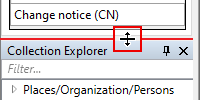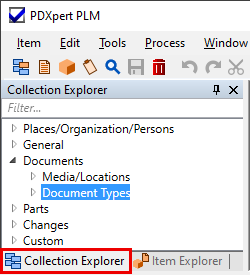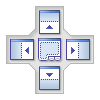PDXpert PLM Software
On-line Help Guide
This help topic describes the current PDXpert PLM release. Earlier releases may be different. To view your release's version of this topic, open PDXpert and press the F1 key or select the Help menu.
Arrange the Explorer windows
You use the Item Explorer and Collection Explorer (the "Explorers") to search for, select and drag collection members (like units of measure) and items (documents, parts and changes). You can drag objects from the Explorers onto lists in the item workspace.
The Explorers can be arranged to best suit the tasks you're performing.
Window management §
Pinning and unpinning (Auto Hide) §
Auto Hide allows you to minimize Explorers along the edges of the PDXpert application window so that the windows do not occupy valuable space. By minimizing Explorers, you can increase the viewable area of the workspace.
You pin or unpin an Explorer by clicking on the thumbtack icon, which toggles between the two modes.
-
 When an Explorer is "pinned" to the workspace, the window will remain
open while you perform other tasks.
When an Explorer is "pinned" to the workspace, the window will remain
open while you perform other tasks. -
 You can unpin your Explorers, which lets them slide back to a tab on the edge
of your workspace where the Explorer is docked. If you position the mouse over
the tab, the Explorer will "slide out" from the tab area.
You can unpin your Explorers, which lets them slide back to a tab on the edge
of your workspace where the Explorer is docked. If you position the mouse over
the tab, the Explorer will "slide out" from the tab area.
Docking and floating §
The Explorers may be "floated" anywhere on the screen, fully independent of the PDXpert application window.
To create a floating Explorer, the window must first be pinned. Then, select the Explorer's title bar and drag it until the preview outline does not snap to any dockable areas. When you release the mouse, the Explorer will float in its own window.
You can dock the Explorer along any edge of the PDXpert application workspace. Select the Explorer's title bar and drag it to one of the four docking images near each window edge.
You can re-dock a floating Explorer window by selecting the command.
Horizontal splitting §
When the windows are stacked, adjust how much workspace is dedicated to each one by dragging the splitter bar.

A splitter bar sets the Explorers within their minimum and maximum sizes. When an Explorer is minimized, only its title bar is displayed.
Adjusting size §
You can increase the size of an Explorer by dragging the edge furthest from its docked edge. The dragged edge position can be different for pinned and unpinned modes.
Grouping as tabs or side-by-side §
This feature automatically groups the Explorers together with tabs representing each Explorer. Only the contents of one tab may be displayed at a time. Only the active tab is closed when the button is clicked and only the active Explorer is unpinned when the thumbtack icon is clicked.

You can arrange the Explorers to be side-by-side, top-and-bottom or overlapping. Drag one Explorer on top of the other, and a positioning aid will appear. Drop the Explorer on one of the four outside images to arrange the Explorers next to each other, or drop the Explorer onto the middle image to overlay the two Explorers.

Item Explorer grid adjustments §
Row selection §
Click on the row to select it. Once the row is selected, you can drag the contents onto another grid, or double-click to open the item.
Column width & location §
You can adjust a column width by dragging the grid line that separates the rows.
Drag a column header to move the related column to a new position.

Column sorting §
Click on the column header to sort the rows by that header. One click will sort the rows in ascending order, a second click will sort the rows in descending order.
Layout suggestions §
Guests §
Guest users who are primarily interested in looking for items can unpin or close the Collection Explorer. You may prefer to dock the Item Explorer along the bottom edge of the workspace if many items have long document titles and part descriptions.
Normal users §
During periods where you're creating many parts or documents, it may be easiest to keep the Collection Explorer pinned on the left window edge, and the Item Explorer pinned along the bottom edge. After you've created the items, you can search for items to drag onto your new items' BOM and Source markups, and when dragging items onto the releasing change form's Affected tab. (The Explorers overlay also works well for these tasks.)
Administrators §
For most administrative tasks, the Collection Explorer can be pinned to the left or right edge of the workspace. Auto-hide (unpin) the Item Explorer.
1153
- 0001. Welcome!
- 0002. Help styles
- 0100. PDXpert Application Server
- 0101. Server overview
- 0200. How to...
- 0300. Console reference
- 0301. Manage
- 0302. Information
- 0303. About
- 0400. How to start the PDXpert client
- 0401. Log into PDXpert
- 0402. Enter the software license key
- 0403. Solve client problems
- 0404. Set your password
- 0500. PDXpert introduction
- 0501. PLM summary
- 0502. Item identification
- 0503. Item iterations
- 0504. Item: Document
- 0505. Item: Part
- 0506. Item: Change form
- 0507. File attachments
- 0508. User roles & permissions
- 0600. How to set up PDXpert
- 0601. Setup introduction
- 0602. Setup: System rules
- 0603. Setup: Collections
- 0604. Setup: Places/Organizations/Persons
- 0605. Setup: General
- 0606. Setup: Documents
- 0607. Setup: Parts
- 0608. Setup: Changes
- 0700. How to use the Item Explorer
- 0701. Item Explorer
- 0702. Make a new item
- 0703. Search for items
- 0704. Use search commands
- 0705. Recent items
- 0706. Files in work
- 0707. Tasks open
- 0708. Open an item related to another item
- 0800. How to use the Collection Explorer
- 0801. View a collection
- 0802. Add a new collection member
- 0803. Modify a collection member
- 0804. Remove a collection member
- 0900. How to work with documents
- 0901. How to work with documents
- 1000. How to start a document
- 1001. Make a new document
- 1002. Snapshot a document
- 1003. Fill in the new document
- 1004. Add or remove references
- 1005. Start and update a task
- 1006. Save your document
- 1007. Remove your document
- 1008. Release your document
- 1009. Manage a released document
- 1010. Revise a released document
- 1011. Cancel a released document
- 1100. How to work with parts
- 1101. How to work with parts
- 1200. How to start a part
- 1201. Make a new part
- 1202. Snapshot a part
- 1203. Fill in the new part
- 1204. Add, modify or remove BOM parts
- 1205. Import a CAD BOM
- 1206. Add or remove approved sources
- 1207. Add or remove references
- 1208. Add or remove materials
- 1209. Start and update a task
- 1210. Save your part
- 1211. Remove your part
- 1212. Release your part
- 1213. Revise a released part
- 1214. Manage a released part
- 1215. Cancel a released part
- 1300. How to revise multiple markups
- 1301. Use Markup Wizard
- 1302. Add child items
- 1303. Replace a child item
- 1304. Remove child items
- 1305. Promote items lifecycle phase
- 1400. How to work with change forms
- 1401. Processing a change
- 1500. How to start a change form
- 1501. Originate a new change form
- 1502. Snapshot a change form
- 1503. Start and update a task
- 1504. Analyze a submitted change
- 1505. Fix change form routing errors
- 1506. Remove your change form
- 1507. Review a routed change
- 1508. Resolve an on-hold change
- 1509. Analyze an accepted change
- 1510. Use a released change
- 1511. View a completed change
- 1512. Analyze a stopped change
- 1513. View a rejected change
- 1514. Remove a canceled change
- 1515. Return a submitted change
- 1600. How to work with file attachments
- 1601. Attach a revision file
- 1602. Attach an item file
- 1603. Attach an external link
- 1604. Viewing a file
- 1605. Copy a file
- 1606. Check out a file
- 1607. Check in a file
- 1608. Free a file lock
- 1609. Remove a revision file
- 1610. Remove item file or link
- 1700. How to report, import & export
- 1701. Run a report
- 1702. Export a PDX package
- 1703. Use the DataGrid
- 1704. Use the Report/Export Wizard
- 1800. Import & update items
- 1801. Use the Batch Importer
- 1802. Item Master import
- 1803. Iteration-level relational imports
- 1804. Bill of materials import
- 1805. References import
- 1806. Revision files import
- 1807. Sources import
- 1808. Item-level relational imports
- 1809. Item files & links import
- 1810. Item materials import
- 1811. Item product families import
- 1812. Groups collection import
- 1813. Materials collection import
- 1814. Organizations collection import
- 1815. Product families collection import
- 1816. Persons collection import
- 1817. Custom collection import
- 1900. View & export via ODBC
- 1901. View database objects
- 1902. Create an ODBC connection
- 1903. ItemViews reference
- 1904. ReferencePairViews reference
- 1905. SourcePairViews reference
- 1906. SourceItemMasterView reference
- 1907. StructurePairViews reference
- 1908. ChangeViews reference
- 1909. ChangePairViews reference
- 1910. FilePairMasterView reference
- 2000. How to do other tasks
- 2001. Adjust your user settings
- 2002. Arrange the Explorer windows
- 2003. Get technical help
- 2004. Manage user accounts
- 2005. Manage system emails
- 2006. Use Administrator Override
- 2007. Check index status
- 2008. Use the Recursion Assistant
- 2100. Menu reference
- 2101. Item menu
- 2102. Edit menu
- 2103. Tools menu
- 2104. Process menu
- 2105. Window menu
- 2106. Help menu
- 2200. Document reference
- 2201. Document summary
- 2202. General
- 2203. Attributes
- 2204. Custom
- 2205. References
- 2206. Appears On
- 2207. Files
- 2208. Tasks
- 2209. Notes
- 2300. Part reference
- 2301. Part summary
- 2302. General
- 2303. Attributes
- 2304. Custom
- 2305. Materials
- 2306. BOM (Bill of Materials)
- 2307. Sources
- 2308. References
- 2309. Appears On
- 2310. Files
- 2311. Tasks
- 2312. Notes
- 2400. Change Form reference
- 2500. System Rules reference
- 2501. System Rules tool
- 2502. General: Copy files to snapshot
- 2503. General: Copy previous tasks
- 2504. General: Item uniqueness definition
- 2505. General: Reviewer comment required
- 2506. General: Unlock change form Files (rule)
- 2507. General: Unlock change form Tasks (rule)
- 2508. Password Policy
- 2509. References Tabs
- 2510. BOM: Limit part to one row
- 2511. BOM: Lock part unit of measure
- 2512. BOM: Allow partner parts
- 2600. Collections reference
- 2601. Managing collections
- 2602. Custom attributes
- 2700. Places/Organizations/Persons
- 2701. Languages
- 2702. Currencies
- 2703. Countries
- 2704. Partner classifications
- 2705. Roles
- 2706. Persons
- 2707. Groups
- 2708. Organizations
- 2800. General
- 2801. Item lifecycle phases
- 2802. Product families
- 2803. Sequences: Identifier
- 2804. Sequences: Revision
- 2805. Unit of Measure categories
- 2806. Units of Measure (UoM)
- 2807. Transforms
- 2808. Views
- 2809. Task Reasons
- 2900. Documents
- 2901. Media/locations
- 2902. Document types
- 3000. Parts
- 3001. BOM type codes
- 3002. Handling/storage categories
- 3003. Make/buy categories
- 3004. Material categories
- 3005. Material constraints
- 3006. Materials
- 3007. Recovery methods
- 3008. Part types
- 3100. Changes
- 3101. Change classifications
- 3102. Change priorities
- 3103. Change reasons
- 3104. Disposition actions
- 3105. Disposition locations
- 3106. Problem sources
- 3107. Change forms
- 3108. Custom collections
- 3200. Other reference topics
- 3201. Keyboard shortcuts
- 3202. PLM software glossary
- 3203. Windows update service
- 3300. Software licenses & legal notices
- 3301. PDXpert license agreement
- 3302. PDXpert end user license terms
- 3303. Other software licenses
- 3304. Legal notices
